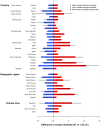Temperature-related mortality impacts under and beyond Paris Agreement climate change scenarios
- PMID: 30405277
- PMCID: PMC6217994
- DOI: 10.1007/s10584-018-2274-3
Temperature-related mortality impacts under and beyond Paris Agreement climate change scenarios
Abstract
The Paris Agreement binds all nations to undertake ambitious efforts to combat climate change, with the commitment to Bhold warming well below 2 °C in global mean temperature (GMT), relative to pre-industrial levels, and to pursue efforts to limit warming to 1.5 °C". The 1.5 °C limit constitutes an ambitious goal for which greater evidence on its benefits for health would help guide policy and potentially increase the motivation for action. Here we contribute to this gap with an assessment on the potential health benefits, in terms of reductions in temperature-related mortality, derived from the compliance to the agreed temperature targets, compared to more extreme warming scenarios. We performed a multi-region analysis in 451 locations in 23 countries with different climate zones, and evaluated changes in heat and cold-related mortality under scenarios consistent with the Paris Agreement targets (1.5 and 2 °C) and more extreme GMT increases (3 and 4 °C), and under the assumption of no changes in demographic distribution and vulnerability. Our results suggest that limiting warming below 2 °C could prevent large increases in temperature-related mortality in most regions worldwide. The comparison between 1.5 and 2 °C is more complex and characterized by higher uncertainty, with geographical differences that indicate potential benefits limited to areas located in warmer climates, where direct climate change impacts will be more discernible.
Keywords: Climate change; Mortality; Projections; Temperature.
Conflict of interest statement
Competing financial interests We declare that we have no competing financial interests.
Figures



References
Grants and funding
LinkOut - more resources
Full Text Sources
Miscellaneous
